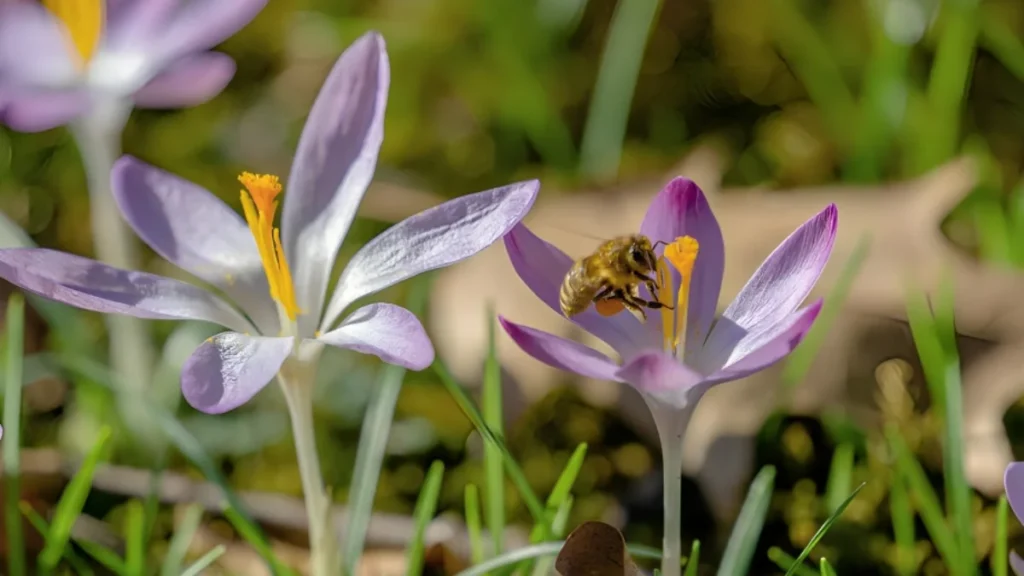Mining bees, another name for ground bees, are a varied species of solitary bees that build their nests in the ground. Since these bees are not aggressive and only sting when directly threatened, they are generally safe for people to be around. Although they are crucial pollinators for the ecology, they may seriously damage grass lawns. To eradicate these ground bees, heed our tips.
Learn how to identify ground bees:
These pointers will help you identify ground bees.
- These bees dig their nests and build foundations or trails on the ground around them. Instead of attempting to differentiate them from other bees, it is simpler to recognize them by their dirt mounds.
- If you spot them flying low in a particular area, they might be ground bees, particularly close to bare soil or sandy patches. These bees can also be recognized by their look. Their length ranges from a quarter to a half inch, and they resemble honeybees in their black and yellow stripes.
- It’s probably not common to see bees flying just above the ground; you’re usually used to seeing them flying around in the air. Bees flying down to the earth could be ground bees. After their breeding season, ground bees go extinct, with the peak activity occurring in the early spring.
how to get rid of ground bees:
Ground bees need to be treated with care and concern. They can be handled safely and efficiently in the following manner.
Ground bees treatment:
Natural Limits
- To prevent these bees from digging their nests, block their nesting tunnels with heavy objects like boulders and stones. It will deter ground bees from returning to their existing burrows. An alternative method of getting rid of bees is to use essential oils such as eucalyptus, peppermint, or tea tree.
- Mulch the area where bees have dug to deter them from returning the next season. Insects will look for alternative places to build nests once they understand they can’t enter or exit.
- Their burrows can be discouraged by spraying them with a solution of vinegar and water. Avoid applying this directly to bees, as it can damage them. Maintain enough moisture in your lawn’s soil to keep them from building nests.
Terminate the Larvae
- You can kill the larvae of these bees to prevent them from reproducing. After developing underground in the nests, the larvae hatch the next spring.
- You can kill them by boiling some water on the stove, adding soap, and then pouring the mixture down the holes the ground bees made. As a result, the larvae will drown. Also, to deter bees, cover the entrance to the nest with a solution of dish detergent and water in the evening, when they are naturally less busy.
Spread an Incentive on the Ground
- Cinnamon is one of the aromas that ground bees, like many other insects, dislike. The areas where ground bees have been excavated should be sprinkled with cinnamon. Applying cinnamon continuously over several days may frequently cause bees to migrate since they dislike the strong smell.
- Another good deterrent is to sprinkle garlic around the nest. Rub the cloves of garlic in some warm water. Before straining and misting the nest, let the mixture settle for a few hours.
Utilize Diatomaceous Earth
- Diatom fossils are used to make this natural powder. Sprinkle the powder directly around the nest’s entrance. The DE starts to work as the bees enter and exit and come into touch with it.
- The best course of action for you might be to hire a professional if none of these techniques work for you or if you just don’t have the time to do so. A skilled pest control service will remove the bees with minimal risk to you and the environment. In addition to eliminating the ground bees, a skilled professional will ensure that they don’t return.
- In particular, during the spring and early summer, ground bees frequently stop by temporarily. Many species go naturally as the season develops.
Conclusion:
In conclusion, solitary bees that build their nests in the ground are called ground bees or mining bees. You can also plant bee-repelling plants such as mint, eucalyptus, or citronella around the perimeter of your yard. To prevent bees from digging in garden beds, think about covering them with a thick layer of mulch or compost. Refer to the preceding guide to learn all the techniques.
Certainly! If you’d like to learn more, please consider following our WhatsApp Channel: Harvest Gardening
A frequently asked questions:
Q1. What are ground bees?
A1. As opposed to hives, ground bees are solitary bees that build their nests in the ground. They can also cause havoc on grassy lawns. Colonies of aggressive wasps that nest in the ground might also take up residence in their nests.
Q2. What kills ground bees instantly?
A2. The fastest technique to kill ground bees is to apply insecticidal dust straight to their nest entrances. In the evening or early morning, when the bees are less active, ground bee nests are best treated.
Q3. Are ground bees stings harmful to plants?
A3. No, plants are not harmed by ground bee stings. Only humans and animals are impacted.
Q4. How can we use ground bee spray?
A4. At twilight or early in the morning, when bee activity is low, apply ground bee spray straight into the nest entrance. For best effects, follow the directions on the spray’s label.

